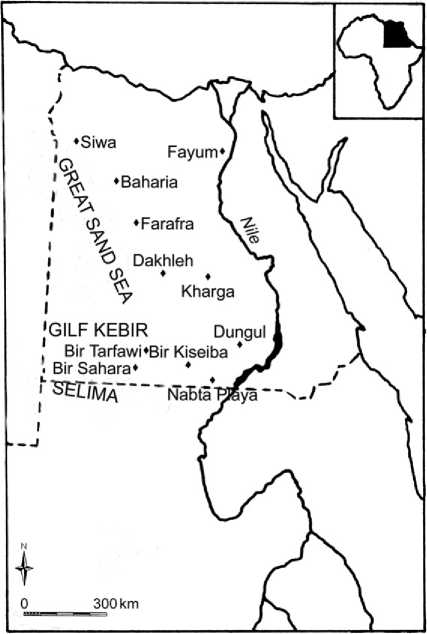Anatomically modern humans are found earlier in southern and eastern Africa then in northern Africa, dating to 250 000 years BP or earlier. The Nile VaLley and the oases in the Western Desert played an essential role by offering water and food resources to the humans who ventured into a landscape that was much drier than their native land. A series of water springs at Kharga Oasis, central-western Egypt, about 150 km west of the Nile, sustained various Middle Stone Age (MSA) human groups using the Levallois technique and producing side-scrapers, Mousterian points, and some denticulates (Figure 1). A later complex was also found at Kharga Oasis, which included tanged tools and bifacial foliates that could be assigned to the Aterian. Tanged pieces were recorded further southeast, at Wadi Dungul, which seems to be the easternmost Aterian site. In fact, the Aterian, which takes its name from the type of site of Bir el Ater, in northeastern Algeria, is a typical late MSA tradition of the Sahara and the Maghreb and does not occur in the Nile Valley. Lithic assemblages are often made with the Levallois technology and comprise typical ‘Middle Paleolithic’ tools, such as side-scrapers and denticulated, as well as ‘Upper Paleolithic’ tools, such as end-scrapers, perforators, and burins. Tanged tools and bifacial foliates were considered as the diagnostic features, but other more frequent elements include bulbar basal thinning and bifacial retouching.
At Bir Tarfawi, in southwestern Egypt, between 175 000 and 70 000 years ago, a sequence of five

Figure 1 Map of sites cited in the text.
Lacustrine events indicated the successive expansions of a lake where people could live and hunt a variety of large animals that are now extinct in the area, including gazelle, warthog, and ostrich, living in a wooded savanna with rainfall of 500 mm per year. They produced a typical MSA industry which included some bifacial foliates that were not significant enough to be assigned to the Aterian. Another MSA site was found at Bir Sahara East, not far from Bir Tarfawi, which revealed a long human occupation, as indicated in a long stratigraphic series. As the age of the earliest level associated with the MSA belongs to the early OIS 6, it is clear that human groups were skilled enough to cope with the severe environmental conditions of the Penultimate Glacial in the Sahara. The age of these populations, their development of MSA technologies, and their abilities to adapt to dry environments and live in open grassland suggest that they were fully modern humans. The technological shift from the production of Acheulean to MSA industries, with a correlated replacement by modern humans, occurred in the late OIS 8 and the cultural progression toward modern behavior took place during the MSA.




 World History
World History









